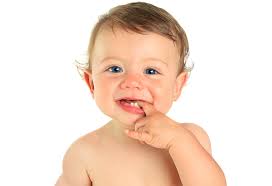
Teething is one of the great mysteries of childhood. There have been so many symptoms associated with teething over the years that at this point it can be really confusing to know when your baby is getting a tooth.
With 20 teeth arriving in the first 2 years of life, it’s easy to see that there can be a lot of overlapping illnesses and behaviours that are often erroneously perceived as teething.
Today I am going to share common issues and queries in the minds of parents regarding teething and basic oral care.
Teething is the process of getting a tooth, and is actually often painless. The average age for the first tooth to appear is 5-7 months and is most often seen on the bottom gum, in the middle.
Teeth don’t actually “cut” through the gums but they move up through a space that is created by the tissues of the gum moving out of the way. In fact, the most common time to see discomfort from teething is prior to teeth coming through.
Babies who are teething may experience fussiness and drooling for 3-5 days prior to a tooth making an appearance.
Sometimes the excessive drooling causes a rash on the face and chin.
Babies DO NOT have high fever, vomiting and diarrhoea, common cold symptoms or weeks of discomfort due to teething. If you think your baby is having any of these symptoms you should seek medical care from your paediatrician.
No, teething does not cause fever or diarrhoea. It is more due to your child placing unclean objects into the mouth. Mobile phones, bag straps,ones own dirty fingers etc. are a very common source of infection.
As teething is not the prolonged excruciatingly painful process, the best options to relieve discomfort.
Try massaging the gums with a clean finger, allowing your baby to chew on cold teething toys or rings, or freeze something soft, like a washcloth, for them to chew on, frozen fruits like banana and berries are also helpful.
Press on the gums with the rounded part of a chilled, clean spoon. Put it in the refrigerator (avoid the freezer because the metal can get too cold and stick to their gums).
Wipe up the drool. Excessive drooling from teething can irritate the skin around the mouth. Try to keep the area dry by wiping off drool frequently with a clean cloth. If necessary, apply a water-based lotion or cream to soothe the skin.
In certain conditions, where baby is febrile or has previous history of febrile seizures, oral paracetamol may be needed as per the paediatrician’s advice.
You can wipe down their gums with a clean, moist washcloth or gauze pad after feedings as early as 3-4 months.
As for when to start brushing baby’s teeth with an actual toothbrush, start when their first primary tooth erupts. Use an infant-sized toothbrush and a smear of fluoride toothpaste – about the size of a grain of rice – to brush their teeth or tooth).
“First visit by 1st birthday” is what is recommended but a visit by the 2nd birthday is advisable, as most of your baby’s teeth would have now erupted.
This is a serious form of decay among young ones. This condition is caused by frequent and long exposures of an infant’s teeth to liquids that contain sugar. Among these liquids are milk (including breast milk), formula, fruit juice and other sweetened drinks.
Putting a baby to bed for a nap or at night with a bottle other than water can cause serious and rapid tooth decay. Sweet liquid pools around the child’s teeth give plaque bacteria an opportunity to produce acids that attack tooth enamel.
Encourage your child to drink from a cup as they approach their first birthday. One should also make sure that children should not fall asleep with a bottle.
After each feed, make sure to lift the upper lip and clean the milk residue with clean moist gauze once your child is asleep. This will reduce the chances of Early Childhood Caries.
Ideally, they should be weaned off bottle-feeding around the age of 1. To wean off the bottle, gradually dilute the contents of the bottle milk or beverage with water over a period of two or three weeks.
Do share your queries or contact me for further guidance if your child is going through this phase.